Belbin measures propensities towards certain kinds of behaviour and styles of interaction with others, rather than personality traits.
There are a number of factors underlying behaviour: personality, motivation, values, abilities and environment, to name a few. So why measure behaviour in particular?
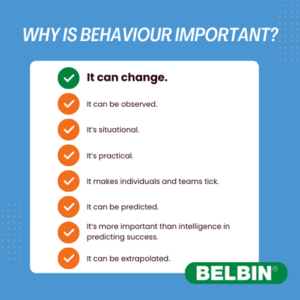
1. It can change.
Personality is fixed and unlikely to change, so it makes sense to focus our efforts at the point where changes can be made: our behaviour. Since behaviour is within our locus of control, affirmative feedback on behaviour offers a positive lead for personal development, showing where and how we can adapt to meet the needs of a particular situation or job role.
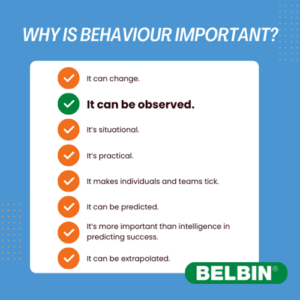
2. It can be observed.
Personality is what’s on the inside; behaviour is what comes out. Behaviour affects – and is affected by – those around us. Measuring behaviour allows us to focus on the words and actions which shape our interactions with others. Arguably, we aren’t experts on someone else’s personality – we don’t know what’s going on “behind the scenes” – but we can comment on what we can see before us.
By giving and receiving feedback on behaviours within a team, we move to a democratic, evidential process. We can corroborate – or disagree with – one another, and provide evidence of the behaviours in question from our own experience. This can depersonalise difficult conversations and take the heat out of conflicts which might otherwise descend into ad hominem attacks. It can also provide a significant learning opportunity – your observers might uncover strengths you didn’t know you possessed.
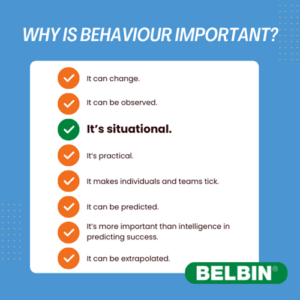
3. It’s situational.
Our behavioural tendencies influence the kinds of work we might be best suited to, and who we work best with. Some people behave very differently at work than they do at home, despite the underlying personality being one and the same. Measuring behaviour in a particular context allows discussion to focus on the workplace, whereas more wide-ranging measurements might muddy the waters.
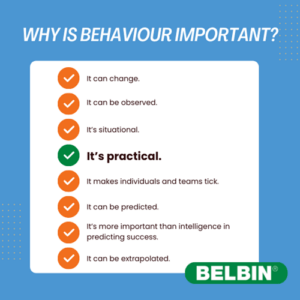
4. It’s practical.
Belbin isn’t a label to apply or a box to put someone in, it’s a language designed to help people better understand each other. Once people understand the Team Roles and the basic concept behind them, this language can be used as a shorthand to describe how different kinds of work might be approached or what sort of contributions are required at a particular meeting.
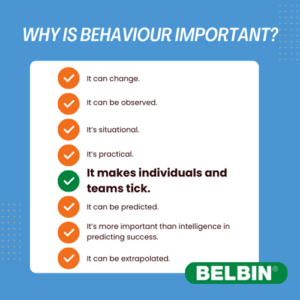
5. It makes individuals and teams tick.
Understanding strengths and weaknesses makes people more engaged, happier and more productive at work, promoting a positive working environment and reducing turnover costs. In 2013, Gallup reported that only 13% of employees were engaged at work. In 2016, their findings showed that teams in the top quartile for engagement outperformed those in the bottom quartile by 21%. In another 2016 study, Harvard Business School outlined the importance of “relational affirmation” in this process: identifying and communicating individual strengths, and using a common language and frame of reference.
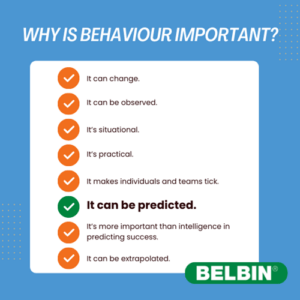
6. It can be predicted.
Since we can observe behaviour, we can predict it too. People may not always behave as we expect in every little way – as human beings, we always possess the capacity to surprise one another – but broadly speaking, we settle into ways of working, communicating and relating to others that can be expected to remain the same over a period of time. This means we can use behavioural styles for recruitment and teambuilding, to suggest whether someone might be a good fit for a particular job role or to join an existing team.
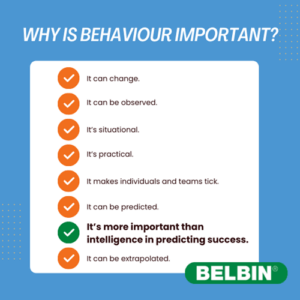
7. It’s more important than intelligence in predicting success.
“The best way to build a great team is not to select individuals for their smarts or accomplishments but to learn how they communicate and to shape and guide the team so that it follows successful communication patterns.” – “The New Science of Building Great Teams”, Alex “Sandy” Pentland, April 2012
As part of his original research at Henley Management College during the 1970s, Dr Belbin set up so-called “Apollo teams”, composed of those individuals who had achieved the highest scores on a battery of intelligence tests. Almost without exception, these teams were the worst performers, owing to competitiveness and negativity within the teams. This initial finding spurred Dr. Belbin on to discover which qualities did predicate success – and Team Role theory was the result.
 8. It can be extrapolated.
8. It can be extrapolated.
Personality comes down to the individual – it’s their outlook on the world. By its very nature, behaviour is more fluid and interconnected with others, so it lends itself naturally to collation. We can aggregate key Team Role information to design and build teams, or map the behavioural preferences of two individuals to examine how well a partnership might work.
Next Steps
You can find out your Belbin Team Role strengths and weaknesses by completing the Belbin Self-Perception Inventory online and (ideally) asking for feedback from your work colleagues. This generates a Belbin Individual report which offers in-depth, personalised advice and guidance.
Read more on the topic
The biggest skeptic is the best decision maker
One thing is for certain – skepticism is a trait both positive and necessary for a team! The reason many of us see skepticism in a negative light arises from a skeptic’s difficulty in communicating pleasantly and diplomatically. In order for a team to make the most out of their skeptic, they must first be discovered, then understood and finally communicated with in the proper way.
Assertiveness and difficult people
Assertiveness is one of the most important skills for teamwork, the presence of which – or lack thereof – we only notice once the situation has gotten tense, interpersonal relationships are on the brink, differing opinions among teammates abound and emotions are boiling.
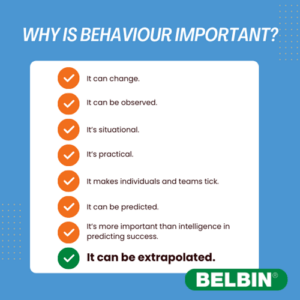 8. It can be extrapolated.
8. It can be extrapolated.
